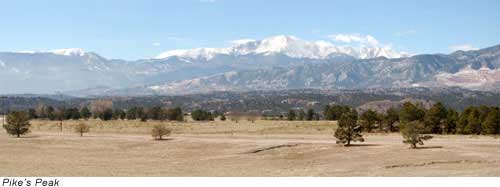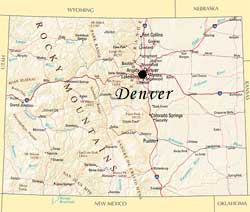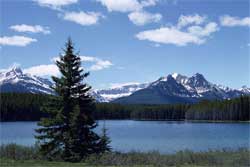
Colorado has an interesting history. During a blizzard in 1806, Zebulon M. Pike tried to climb to the top of the best-known Rocky Mountain peak in Colorado. It was 14,110 feet above sea level. However, his crew didn't have enough warm clothing or rations and was forced to turn back. The mountain's peak was named "Pike's Peak" after him and was described as unscalable by Pike. Fourteen years later, in 1820, Dr. Edwin James accomplished what Pike couldn't; he reached the top.

"Pikes Peak or Bust!" Prospectors wrote that on their wagons in 1859 as they headed for gold mines in Colorado. The state's mountains and plateaus are filled with gold, silver, and other minerals. Today, however, petroleum, is the state's most important mineral product.
Colorado is named after the Colorado River. Its name means "colored red" in Spanish. The river was named this because of the many colorful rock formations seen in the state's mountains and western plateaus. Colorado's nickname is the "Centennial State" because it joined the Union on the 100th anniversary of the Declaration of Independence. The abbreviation for Colorado is CO.

 Colorado is a Rocky Mountain state bordered by Wyoming to the north, Kansas to the east, Mexico to the south, and Utah to the west. The state is famous for its elevation. Its average elevation, at over one mile above sea level, is the highest in the nation. Denver, the capital and largest city, is known as the "Mile High City." The Denver Broncos, a National Football League team, play in Mile High Stadium. This forces football players to use oxygen masks because the stadium's air is so thin. Colorado is a Rocky Mountain state bordered by Wyoming to the north, Kansas to the east, Mexico to the south, and Utah to the west. The state is famous for its elevation. Its average elevation, at over one mile above sea level, is the highest in the nation. Denver, the capital and largest city, is known as the "Mile High City." The Denver Broncos, a National Football League team, play in Mile High Stadium. This forces football players to use oxygen masks because the stadium's air is so thin.
Speaking of heights, Colorado has 51 of the 80 highest North American peaks. The Rocky Mountains run through the state. The Continental Divide, which separates rivers that flow into the Gulf of Mexico from those that flow into the Pacific Ocean, cuts through Colorado's Rocky Mountain National Park. The sources of many rivers, including the Rio Grande, Colorado, Arkansas, and South Platte rivers, are in Colorado. And in the state, one can travel across the world's highest suspension bridge and gaze down more than 1,000 feet at the state's spectacular canyon, Royal Gorge.
Even though, the state is known for its great elevations, it's not all mountains. The eastern third of the state is part of the Great Plains. Hay, wheat, potatoes, corn, and sugar beets are all grown in this section of Colorado. Colorado's Rocky Mountain mines are the nation's leading producer of molybdenum, which is used to harden steel.

 Colorado is a main transportation and distribution center for the Rocky Mountain region. This is because it is located about halfway between the major cities in California and the Midwest. Because of its location, many large banks and manufacturing companies have established branch offices in the state. The United States Government owns more than a third of Colorado's land, where it controls grazing, mining, and logging. Colorado is a main transportation and distribution center for the Rocky Mountain region. This is because it is located about halfway between the major cities in California and the Midwest. Because of its location, many large banks and manufacturing companies have established branch offices in the state. The United States Government owns more than a third of Colorado's land, where it controls grazing, mining, and logging.
If you like war planes, Colorado could be the state for you. The United States Air Force Academy and defense headquarters are located in the state. The North American Aerospace Defense Command is located 1,200 feet underground in Cheyenne Mountain, near Colorado Springs.

The beautiful scenery of the Rockies and the state's cool, pleasant summer climate have made Colorado a favorite of tourists. Aspen is a world famous ski resort. Estes Park, Steamboat Springs, Vail, and Colorado Springs, are also popular resorts. And for any fan of the movie "Jurassic Park," Colorado shares Dinosaur National Monument with Utah. It has thousands of dinosaur bones from the Jurassic period. And one can also see prehistoric cliff dwellings built by the Anasazi, an early Indian tribe, in Mesa Verde National Park.
|

![]()
